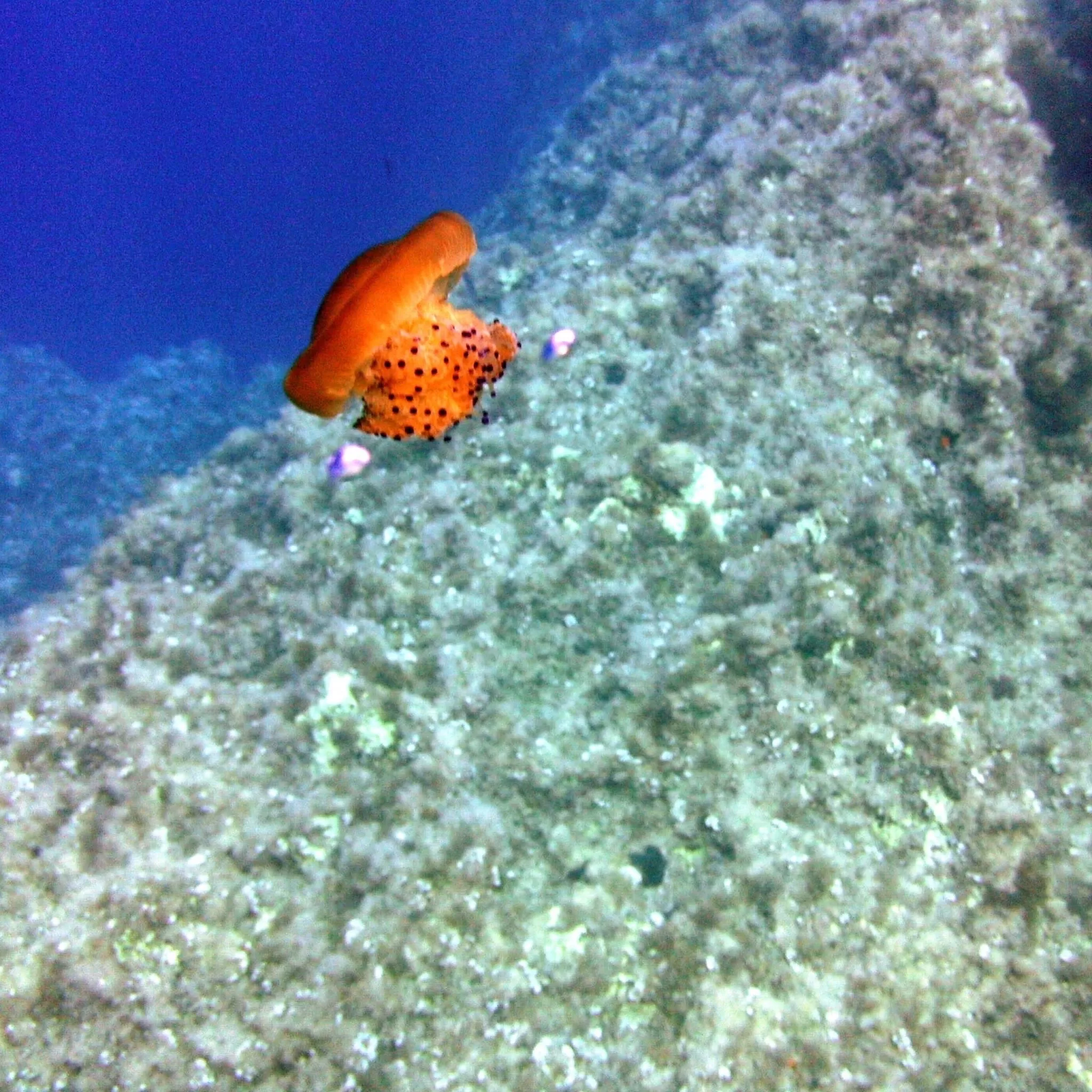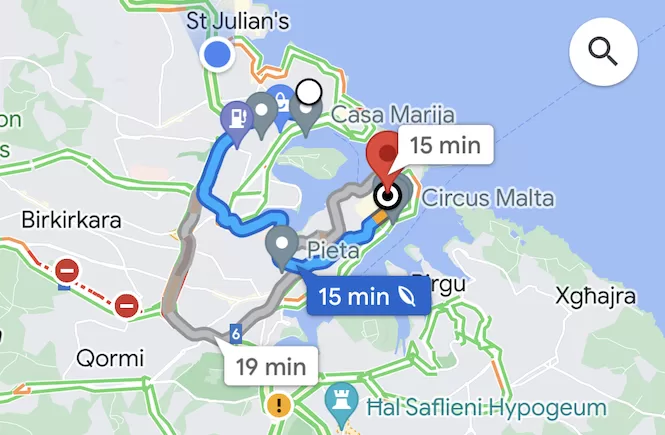Just a quick heads up – some of the links I share on this site are affiliate links. That means if you click on one and make a purchase, I may earn a small commission at no extra cost to you. Your support through these links helps me create valuable content.
Let’s face it: jellyfish in Malta can disturb your vacation. But fear not! By arming yourself with the right information and a little planning, you can greatly reduce the risk and enjoy a worry-free holiday on Malta’s beaches.
Jellyfish in Malta: The Species
Jellyfish: brainless, bloodless, boneless, and oh-so-fascinating! These mesmerising creatures have been part of our marine ecosystem for millions of years.
While their stings may concern, they play a vital role in the aquatic food chain. Let’s dive into some jellyfish species you might encounter while swimming in Malta’s warm waters.
Meet the Mauve Stinger, a common sight with its pink mushroom-shaped head and long tentacles. This species migrates to warmer waters for reproduction, so they are common in spring and summer.

Credit: Photo by Jane Ta on Unsplash
Next, say hello to the Compass Jellyfish, easily identifiable by its yellowish head adorned with compass-like markings.
As summer ends, in September, keep an eye out for the Fried Egg Jellyfish. This species is easily recognisable by its unique fried egg-like appearance. Its sting is mild, barely affecting humans, and you might even see small fish sheltering beneath it.

The elegant By-the-Wind Sailor is a blue, oval-shaped jellyfish that gracefully floats on the sea’s surface, carried by the wind. While storms often wash them ashore between January and May, their sting is only mildly irritating.
Don’t be fooled by the Upside-Down Jellyfish, which lives inverted on the sea floor. Its fiery blue tentacles resemble dancing flames, but be cautious as it has a mild sting.
Lastly, watch out for the Portuguese Man o’ War, a more dangerous species resembling the By-the-Wind Sailor. Its venom remains potent even after death, so alert authorities if you come across one and keep your distance.
Are you planning to visit Blue Lagoon in Comino? Check out my guide to the best Blue Lagoon boat tours.
Choosing the Jellyfish-Safe Bays in Malta
Relax! Despite the variety of jellyfish in Malta’s waters, you can plan beach days without worrying. Malta’s diverse coastline offers a number of jellyfish-free beaches, allowing you to fully enjoy the sun, sea, and sand.
Remember, Malta jellyfish’ presence is influenced by tides and winds, so it’s about being in the right place at the right time.
Thankfully, the Maltese coast offers beaches facing different directions, increasing your chances of finding a beach free of jellyfish. So get ahead, and dip into Malta’s blue waters without worrying about unexpected stings.
To help you navigate the jellyfish situation, several online resources list jellyfish-free beaches in Malta and Gozo.
I usually check the “Recommended Bays” section on malteseislandsweather.com for daily updates. These resources ensure you stay well-informed about jellyfish conditions before packing your beach bag.
Travel Timing: Jellyfish Seasons in Malta
Timing is everything for jellyfish activity in Malta. Based on years of observation, the Mauve Stinger, a prevalent jellyfish species, tends to appear as the temperature rises in April and cools down in September.
You can expect their presence to peak in June. As the waters warm up, these fascinating creatures often retreat to deeper areas where temperatures are cooler.
In April and early May 2025, large swarms of mauve stinger jellyfish appeared along Malta’s southern coast. Marine biologist Alan Deidun explained that because this bloom happened early, there may be fewer jellyfish at Maltese beaches later in the summer. Actually, I haven’t see many when swimming this summer so far.

Get a FREE Attractions Map
Planning a trip to Malta, Gozo, or Comino? Get this free interactive map filled with insider tips, Google Maps links, and more.
Jellyfish in Malta: Staying Safe
When it comes to safety, a bit of preparation goes a long way. Daily online checks will help you identify jellyfish-free beaches, and remember to bring a snorkelling mask. Not only does it allow you to spot and avoid jellyfish, but it also lets you marvel at the beautiful fish swimming beneath the surface.
In the unfortunate event of a jellyfish sting, here’s what to do:
- Exit the water and reach dry land for your safety.
- Rinse the affected area with seawater, avoiding fresh water as it can worsen the sting.
- If available, apply vinegar to neutralise the venom.
- Safely remove any tentacles using tweezers and rinse the area again.
- To alleviate itching and swelling, consider using hydrocortisone cream or taking an oral antihistamine.
- If the sting causes an open wound, keep it clean, apply antibiotic ointment, and cover it with a bandage.
- Seek immediate medical attention if severe allergic reactions occur, if the sting covers more than half an arm or leg, or if it is from a Portuguese Man o’ War.

Join my FREE private Facebook group, Malta Travel Tips, where you’ll find helpful resources and connect with other travellers just like you!
Jellyfish in Malta: FAQ
When is jellyfish season in Malta?
Jellyfish season in Malta typically begins as the weather warms up in April and continues until it cools down in September. The Mauve Stinger jellyfish is the most painful in Malta. It tends to be most abundant in June. But, each summer may bring unique conditions that can impact the presence of jellyfish. For instance, in 2022, there was a big rise in jellyfish numbers. This was due to cooler sea temperatures in March which affected their growth and reproduction cycle. However, in 2025 it’s predicted that there will be fewer jellyfish in summer.
Are jellyfish in Malta poisonous?
Not all jellyfish in Malta are considered poisonous to humans, but some can deliver painful stings. For instance, the Mauve Stinger is common in Malta. It is known for its painful stings, which can cause infection. The second most popular species is the Fried Egg Jellyfish. They have mild stings that barely affect humans.
What are the brown-yellow spotted jellyfish in Malta?
The brown spotted jellyfish mentioned is commonly known as the Fried Egg Jellyfish. It can be easily identified by its resemblance to a fried egg, with a yellowish centre and a see-through outer brown body. These jellyfish have a gentle sting that rarely bothers people.
By following these guidelines and other tips on staying safe, you’ll be well-prepared to enjoy Malta. So, embrace the calm confidence of a well-informed traveller and focus on creating lasting memories during your holiday.
Don’t forget to check out the Malta beaches map guide for a comprehensive resource on stunning beaches. In addition, check out my post on secluded beaches in Gozo for some hidden gems waiting to be discovered. Happy beach hopping!




